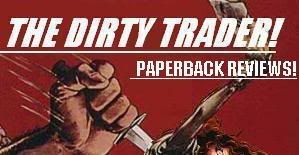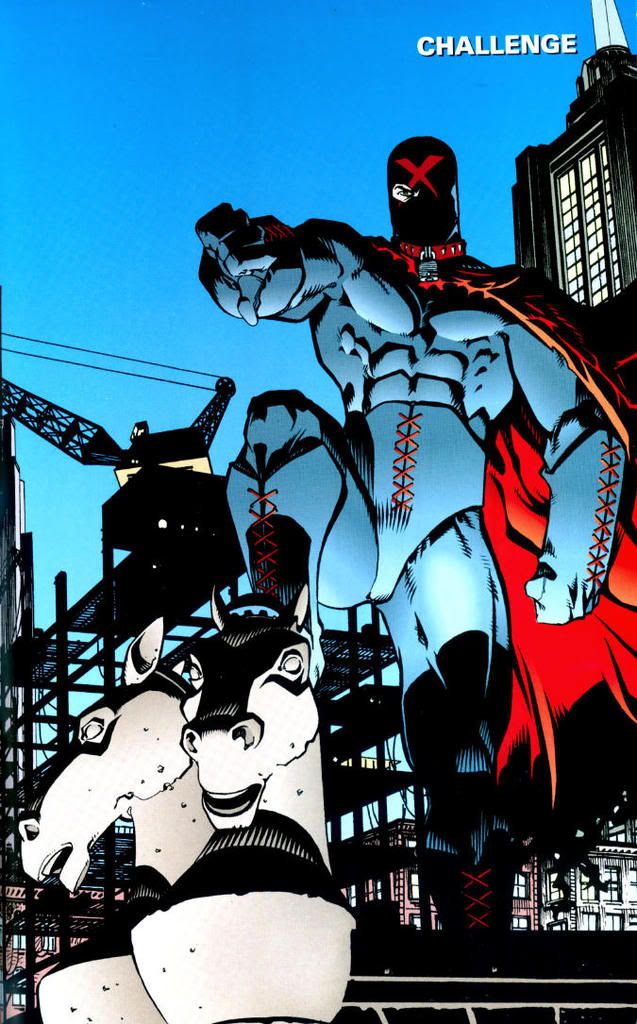

Like a number of other people, I was enticed by Dark Horse's late-in-the-boom attempt to launch a super-hero line. I've embraced a number of publishers' lines over the years, but always kept my distance from Dark Horse. For some reason, Mike Richardson's company always struck me as having the same aloof, cynical vibe as some European comics-- like they were better than the American industry, yet willing to slum. As the company shifted gears from the publisher of creator-owned properties and licensed fare to the generator of licensable company properties, foremost at the time being "Comics Greatest World," my aversion only grew. Still, I'd been burned by Marvel's corporate heroes, lost First's corporate heroes, and was only beginning to expand my interest in DC's corporate heroes. Why not at least give them a shot, especially at $4 a month for four months?
Well, I did, and the whole thing left me cold. Each installment just barely introduced a character type, the artists were mercenaries, the writers were editors, the designs were flat and the overarching story merely a prelude to nothing much. Of the lot, the only charater to hold my interest was X. By God, but X was well designed. Simultaneously recalling the primal 40's vigilantes, 70's punk, 80's pro wrestlers and 90's bondage freak, X looked like a perfect storm of fucked-up cool. His was the first installment of "Comics Greatest World," among the best drawn, and as the entry point was allowed to be mysterious. Of course, by the end of "Comics Greatest World," the whole premise of the line was still vague, and burnout set in. I passed on the few spin-off series.
All these years later, Dark Horse has hopped on the fat-fucking-omnibus at a reasonable price bandwagon, and I opted to climb on for X. I'm a big fan of writer Steven Grant's inciteful weekly CBR column Permanent Damage, and artist Doug Mahnke became a favorite of mine in the oughts. That's why it pains me to report "X" as a crushing failure. "X" is a concept without a personality, the kind of character Robin the Boy Wonder was created to support, but no such luck here. X is a force of nature, which only works as an antagonistic presence. His prey must become the stars of a given story, with the reader viewing the world through their eyes. These P.O.V. figures are a bunch of one-note goombas that only serve as cannon fodder. Each episode plays like a crap 80's slasher movie, replacing machetes with automatics. Mahnke's style was still developing, and here looks soft and unfinished. Jimmy Palmiotti's inks did him no favors. At 352 pages, it takes a while to read through the little brick, which becomes quite a chore once you realize each episode is just a minor variation on a tired theme.
- "One Shot To The Head" collects the earliest X short stories from "Dark Horse Comics #8-10." It was here I realized that "Comics Greatest World: X" had been reprinted in another omnibus, which ticked me off. The entry tale was by Jerry Prosser, which introduces the corrupt city of Arcadia and the relentless X-Killer stalking its officials and criminals. The story is ill served by the substandard pencil work of N. Steven Harris.
- "Abandoned Hearts" picks up with the first issue of the "X" ongoing series. Mahnke, a body-building enthusist, is wonderful at depicting massive, clearly referenced frame. He's even got that pronounced "builder butt" that makes some guys look simian. X is so well realized, you can't help but notice the contrast with the lightly rendered secondary characters and dimensionless backgrounds. Grant introduces Tango, a cartoonish mafia don with a fixation on astrology, and an unwanted kid sidekick who pops up randomly throughout the series to no effect. I don't recall if the kid was ever given a name or assigned a gender. The kid is that thin.
- "Copycat" falls under the heading of "too soon," as X hadn't built up enough of a presence in the reader's mind to warrant an "evil" duplicate. Far more grievous was Grant's introduction of a black islander blind homeless man who speaks in heavily accented rhyme. He sits in front of city hall and gathers information for X, while being dismissed as a crazy man. He's like the nexus point of all cliche in the known universe-- so much so I assume it must have been intentional, but is no less annoying for it. He's so awful and contrived, I'm surprise the book didn't implode right there. He also randomly appears, mostly to give the impression of a supporting cast where no such thing actually exists. As a plot device, he was repeatedly pointless.
- "Welcome to the Jungle," parts one and two, from "Dark Horse Comics #19 & 20." Writer Eric Luke mostly uses X as an excuse for a policeman to tour Arcadia, and focuses largely on the super-human SWAT team called "Pit Bulls." This is probably what the "X" series should have been, but lacks Grant's maniacal drive, the book's main charm. Grant is all about X, who's nucking fucks, and takes every situation to its most grisly extreme. Without that gonzo quality, X is just another bullshit nighttime avenger. The art by Nghia Lam is nice, recalling early Jason Pearson.
- "Big Guns" returns to the regular series and creative team, in a downtown battle against cyborgs that read like the end of Miller and Mazzuchelli's "Born Again" on meth. Mahnke is plainly faltering under the monthly grind.
- "The Coming of the Chaos Riders" New characters are introduced at random for no real reason besides X needing someone besides gangsters and politicians to punch and stab. Both the best and worst thing about this series is arbitrary shit like this. At least it keeps things moving very rapidly in a vicious circle.
- "Riders of the Storm." More of the same, with the art continuing to deteriorate. Some vague reference to X's origins and a crossover event are made, but never resolved.
- "Challenge" starts off with a fantastic original cover by Dave Johnson (see above) depicting X giving a imperial "thumbs down" on a rooftop. This is a megalomanic self-appointed arbiter of who lives and dies in his city, and what will occur within its confines. It sums up X perfectly. On the other hand, Grant's story and art by Vince Giarrano are absolute shit. Reprinting "X: Hero Illustrated Special #1," it introduces a new foe for X that does not reappear in this volume, partly because he's rendered impotent inside 12 pages.
- "The Scream," a.k.a. "X: Hero Illustrated Special #2," is more of the same, but somehow far worse. Another new villain drives the tale, a raving madman whose dialogue is nearly as off-putting as the blind black derelict islander's, and in far more substantial portions. Incompetently drawn by Corky Lehmkuhl, this promotional piece was the perfect insurance against gaining any new readers.
- "Devils" makes that a shame, as it's one of the single best issues of the series. Three lovely pages of art by P. Craig Russell depicted Steven Grant's inspired riff on a millenium old premise, and then Ron Wagner follows through on the update with some of his finest pencils. A worthy adversary is introduced, and X's infallibility brought into question. Joe Quesada's cover isn't one of his best, but it ain't bad, either.
- "Trigger Man" continues the tale, sans the extra artists. Palmiotti was on a Bill Sienkiewicz trip at the time, which served Wagner's pencils far better than Sal Bucema on Spider-Man. Unfortunately, the extra effort seemed to require the additional embellishment of Frank Fosco, who can suck rocks through a straw. The villain retains his menace at issue's end, X has an actual arc, and the overall story ramps up. This one could have used a third issue, where most X "stories" feel interchangeable and disposable.
- "Edge of Nowhere" teases prime Matt Haley art on the cover, less reliable work within. The lead character was so taxed in the previous two issues, this one is given over to Ghost, a spectral avenger with her own series at the time. The heroine brings out a ponderous, purple prose in Grant I could have done without. The story was so tonally divorced from the rest of the book, I kept checking to see if it was actually an issue of "X."
- "Evil Nets" featured the last, best overall art by Mahnke on the series, though it sacrificed the more iconic X posturing. The Übermensch is back in full force for an underworld massacre, more super-creeps climb out of the woodwork, and schemes of consequence take shape.
- "Fringe of Judgment." Chris Warner, who I believe designed the character (though perish the thought of a creator credit,) returns for a pair of fantastic issues inked by Tim Bradstreet. Another memorable cover here, of X definatly detonating an explosive charge in a nearby building. Hostilities escalate, and a proper nemesis for X appears.
- "Black Rain" sees more scheming, another new menaces, and a victory for the bad guys. It also sees the end of the volume, which took much to long to reach a point of interest for me to rush out and buy Volume 2.
As you can see, there's a lot of good to be found in the "X" series, but it's also such an inconsitent mess of guilty pleasures, I wouldn't put my good name on the line by recommending it either. You get a lot and very little for $24.95, depending on your viewpoint. I understand Javier Saltares supplies most of the art for the rest of the run, which is a selling point for me, as I'd expect he was in his prime where Mahnke was a troubled adolescent. I don't know, but for now I'm marking against this book. "One warning, one mark. The second mark is the mark of death."


No comments:
Post a Comment